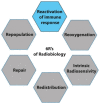The 6th R of Radiobiology: Reactivation of Anti-Tumor Immune Response
- PMID: 31226866
- PMCID: PMC6627091
- DOI: 10.3390/cancers11060860
The 6th R of Radiobiology: Reactivation of Anti-Tumor Immune Response
Abstract
Historically, the 4Rs and then the 5Rs of radiobiology explained the effect of radiation therapy (RT) fractionation on the treatment efficacy. These 5Rs are: Repair, Redistribution, Reoxygenation, Repopulation and, more recently, intrinsic Radiosensitivity. Advances in radiobiology have demonstrated that RT is able to modify the tumor micro environment (TME) and to induce a local and systemic (abscopal effect) immune response. Conversely, RT is able to increase some immunosuppressive barriers, which can lead to tumor radioresistance. Fractionation and dose can affect the immunomodulatory properties of RT. Here, we review how fractionation, dose and timing shape the RT-induced anti-tumor immune response and the therapeutic effect of RT. We discuss how immunomodulators targeting immune checkpoint inhibitors and the cGAS/STING (cyclic GMP-AMP Synthase/Stimulator of Interferon Genes) pathway can be successfully combined with RT. We then review current trials evaluating the RT/Immunotherapy combination efficacy and suggest new innovative associations of RT with immunotherapies currently used in clinic or in development with strategic schedule administration (fractionation, dose, and timing) to reverse immune-related radioresistance. Overall, our work will present the existing evidence supporting the claim that the reactivation of the anti-tumor immune response can be regarded as the 6th R of Radiobiology.
Keywords: immune response; radiotherapy fractionation; radiotherapy-immunotherapy association.
Conflict of interest statement
Lionel Apetoh has performed consulting work for Roche, Bristol-Myers Squibb and Merck and receives a research grant from Sanofi. The other authors declare no conflict of interest.
Figures



References
-
- Withers H.R. The Four R’s of radiotherapy. Adv. Radiat. Biol. 1975;5:241–247.
Publication types
LinkOut - more resources
Full Text Sources
Research Materials

